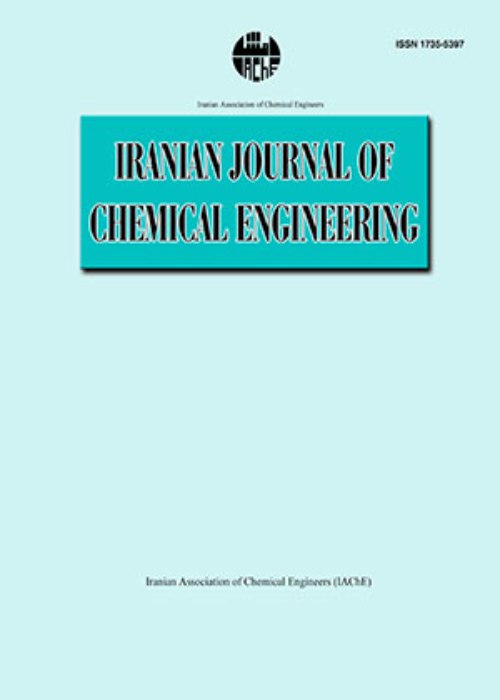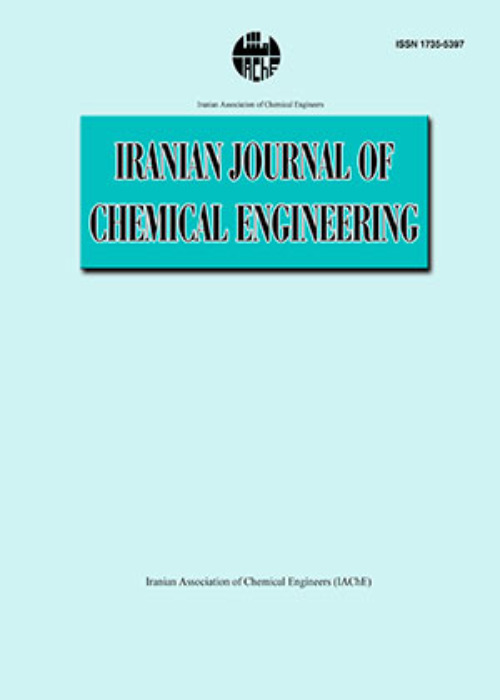فهرست مطالب

Iranian journal of chemical engineering
Volume:20 Issue: 3, Summer 2023
- تاریخ انتشار: 1402/11/18
- تعداد عناوین: 6
-
-
Pages 3-20
The properties of the Nanoclay-corn starch film were studied in the presence of Nanostarch. Nanostarch was synthesized through nanoprecipitation and characterized using the Particle Size Distribution Analysis, Field Emission Scanning Electron Microscopy (FESEM), X-ray diffraction Analysis (XRD), and Fourier Transform Infrared Analysis (FTIR). The XRD analysis of nanostarch particles revealed a distinctive V-type diffraction peak, with particle diameters ranging from 25 to 100 nm. The impact of introducing nanostarch into the starch-nanoclay film was investigated in terms of the thickness, transparency, morphology, wettability, and mechanical properties of the nanocomposite film. The results indicated that adding nanostarch particles improved the optical transparency of the film along with its hydrophobicity and flexibility. The film having a weight ratio of 0.769 (nanoclay to nanostarch) showed the maximum hydrophobicity (107.85°), and elongation at break (58.6%). This suggests that the appropriate incorporation of nanostarch can enhance the film's flexibility. The maximum tensile strength (5.88 MPa) was obtained for the film with a weight ratio of 1 (nanoclay to nanostarch).
Keywords: Nanostarch, Nanocomposite, corn starch, Nanoclay, Transparency -
Pages 21-54
In the present study, a new method has been suggested to solve the problems of the very low solubilityof sulfide ores in acidic solution and also the production of toxic impurities for the first time. In this work, the polyoxometalate (POM) oxidizer was applied for the dissolution of sulfide ores, extraction of metals, and removal of toxic and harmful wastes. In this procedure, POMs were used as strong oxidizers of sulfur compounds to dissolve sulfide ores. Also, acid was applied as a solvent and catalyst to increase the reaction rate. The Taguchi experimental design along with the ProMax simulation software was applied for studying the leaching of sulfide ores by POM oxidizers as a novel plan in experimental to industrial scales. The optimum data achieved by the Taguchi method was used as the input data to the simulation and sensitivity analysis of the process was executed by the ProMax software. The effects of curicital operating parameters such as the concentration of acid (CA) in the 60-90 g/l range, the reaction temperature (TR) with the values of 60-90 ºC, the rotation rate (R) with the amounts of 50- 300 rpm, the retention time (τ) in the 0.5-2.0 h range, the concentration of polyoxometalate oxidizer with the values of 0.1- 0.5 g/l, the acid types of H2SO4, HNO3, HCl, H3PO4, the grain sizes of sulfide ores (Sparticle) in the 0.5-3.0 mm range and polyoxometalate with the types of [Mo6O19]2-, [Mo8O26]4-, [V10O28]6- and [H2W12O40]10- on the extraction efficiency of metals and removal of toxic heavy metals from sulfide ores by polyoxometalates were investigated. The optimum conditions to extract maximize metals from the sulfide ores were obtained as the CA; 80 g/l, TR; 90 ºC, R; 300 rpm, τ; 1.0 h, m POMs; 0.5g/l, acid type of H2SO4, Sgrain;1.0 mm and POMs type of [H2W12O40]10-. Under optimized conditions, the extraction efficiency of zinc, copper, and lead and the removal of toxic heavy metals from sulfide ores were determined as above 85%, 81%, 83%, and 99.9% receptivity.
Keywords: Processes simulation, ProMax software, Taguchi Experimental Design, optimization -
Pages 45-53
In this study, carbon nanotubes were fully aligned by chemical vapor deposition at atmospheric pressure on a silicon substrate at two carbon source flow rates of 28 and 38 sccm (standard cubic centimeter per minute). Acetylene gas (C2H2) as the carbon source for argon gas (Ar) as the carrier gas for hydrogen gas (H2) for the recovery of the nanoparticle and iron nanoparticles as the catalytic source at 800 °C were used for the growth of the carbon nanotube array. The reaction was carried out in a 48 cm long quartz tube and the gases were injected with specified flow rates. The silicon substrate was coated by the magnetic sputtering method with catalytic iron nanoparticles with a thickness in the range of 3-6 nm. The results of the FESEM analysis showed, as the carbon source flow rate was increased to 38 sccm, the average diameter of the grown carbon nanotubes is increased, and the carbon nanotubes with a diameter of 60-70 nm were most abundant.
Keywords: Super-aligned carbon nanotube arrays, Chemical vapor deposition (CVD), FESEM analysis, Acetylene gas, Hydrogen gas -
Pages 54-69
The application of the agro-industrial waste as the feedstock helps to decrease the operational cost of the fermentation process. Soapstock is a by-product of the vegetable oil refinery and enriched with fatty acids including linoleic acid which has a high potential application in the production of biosurfactants. In this study, a dual carbon source system, including glucose and free fatty acids recovered from a sunflower soapstock, was used for the synthesis of sophorolipid (SL) by Candida catenulata. The production of SL showed a major dependence on the initial carbon sources and the concentration of urea as the nitrogen source. The inoculum size was another influential factor in the fermentation process. The optimization of these factors was evaluated by the one-factor-at-a-time and the response surface methodology (RSM). The one-factor-at-a-time approach gained the best SL productivity (Y1) of about 52.08 mg L-1 h-1 and SL-to-biomass yield (Y2) of 712 mgSL gcell-1 at the inoculum size of 4% vv-1, 100 g L-1 of glucose, 80 g L-1 of soapstock, and 7.5 g L-1 of urea. While the RSM, due to considering interactional effects of the factors, obtained the best condition at 100 g L-1 of glucose, 100 g L-1 of the soapstock, 9.3 g L-1 of urea, and an inoculum size of 6.3% vv-1 with the Y1 and Y1 values of about 58.10 mg L-1 h-1 and 713 mgSL gcell-1, respectively. The characterization of the produced SLs by the GC-MS analysis indicated that a di-acylated C16:1 acidic sophorolipid with an m/z ratio of 679 amu was the main product.
Keywords: Biosurfactant production, Cultivation conditions, Process Optimization, Response Surface Methodology, Agro-industrial waste -
Pages 70-89
Amine gas sweetening is a process in which acidic gases including hydrogen sulfide (H2S) and carbon dioxide (CO2) are removed by a solution of water and amines. Many parameters influence the sweetening process. Knowledge about the important parameters and their degree of importance is of great interest to achieve the optimum condition. Nine effective parameters including the CO2 and H2S contents of the feed, the temperature and pressure of the feed, the tray number and pressure of the absorber, the lean amine temperature, and the concentrations of Methyl Diethanol Amine (MDEA), and Piperazine (PZ) have been chosen as effective variables, while CO2/H2S recovery and total process energy have been considered as response variables. After the verification of the present study with real plant data, the experimental layout was designed by the Plackett-Burman approach, and the model validation has been confirmed by ANOVA. The results of the present study showed that the most effective parameters in the CO2 recovery are the absorber tray number and PZ concentration, while in the H2S recovery, the absorber tray number is the most important variable. Regarding the total energy of the proces, feed temperature, PZ concentration, absorber tray number, lean amine temperature, and feed pressure are obtained as important variables. The optimum condition has been obtained in the feed and absorber pressures of 5758.9, and 1458.9 kPa respectively, with the feed and lean amine temperature of 0.11 and 50 respectively, the concentrations of 17.57 and 3.8 wt.% of MDEA and PZ respectively, the absorber tray number of 20 and the mass flow rates of 792 and 103.6 kg/h of CO2 and H2S respectively. Under the mentioned conditions, the CO2 and H2S recovery were achieved at 99.99 % while the total energy of the process was 3.56 Mw.
Keywords: Gas Sweetening, Plackett-Burman approach, Methyl Diethanol Amine, optimization -
Pages 90-103
The cementation reaction of Ni-Cd occurs on the surface of zinc powder, and the Ni-Cd ions in the zinc sulfate solution (make-up) change into a solid metal deposit during the process. The primary purpose of this study is to evaluate the effect of the particle size of zinc powder on the operational parameters of cementation, such as the quantity of the zinc powder used, the reaction temperature, and the contact time. These parameters are influential on cost reduction as well as the manufacturing rate of zinc ingot. Results indicated that providing that the zinc powder, -325 mesh, is used, the consumption of zinc powder used in the industry can be reduced by an average of 40%. It was also confirmed that the best times for the cementation of Ni-Cd for all studied sizes were 75 and 60 minutes respectively. The Ni and Ca were removed in -325 mesh to the optimal values at 85℃ and 65℃ respectively. By optimizing the evaluated parameters, the concentrations of Ni and Cd impurities were obtained at the lowest possible and acceptable levels for transferring the make-up solution to the electrolysis stage.
Keywords: Zinc powder size, Ni-Cd removal, Cementation, Cold purification, zinc manufacturing process


